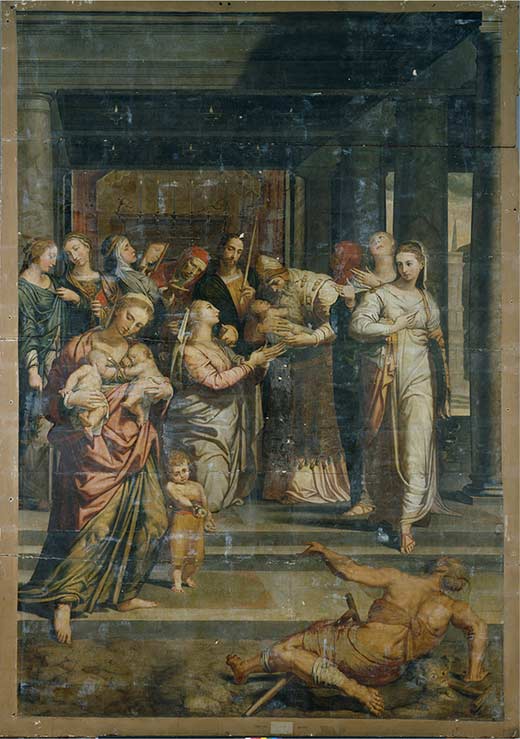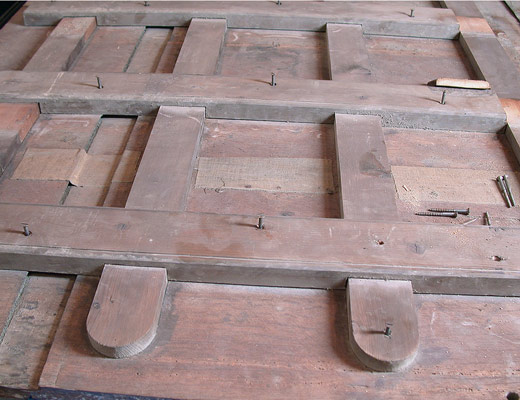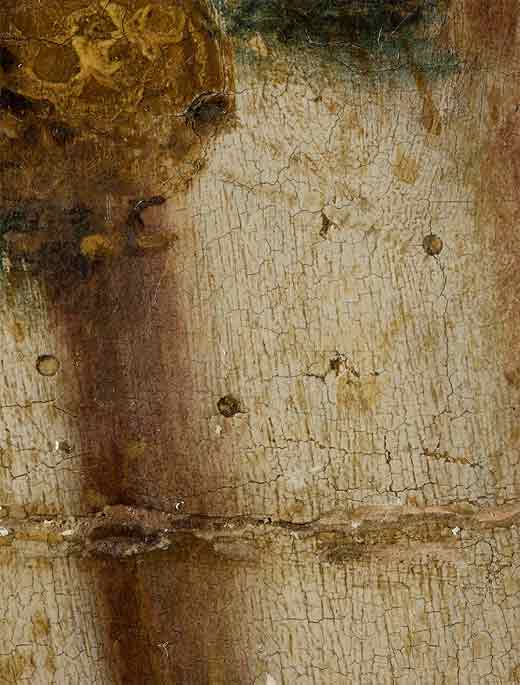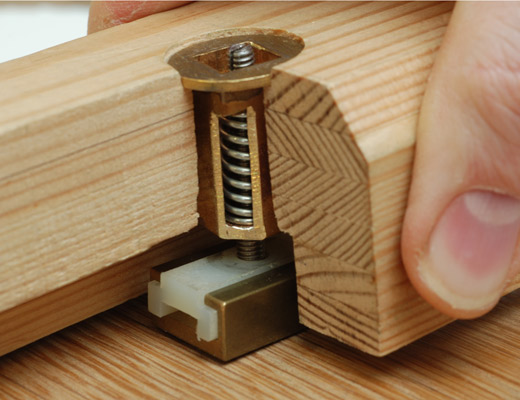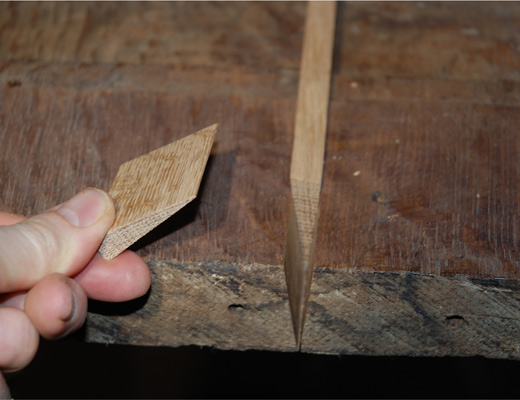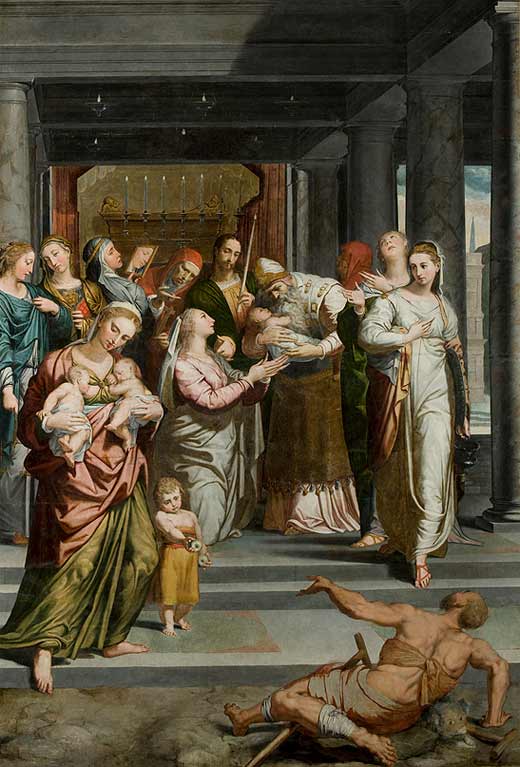Cargando ...
The Restoration of The Purification of the Virgin in the Temple by Pedro de Campaña 2 December 2008
Following a lengthy and complex process of restoration undertaken in the Prado’s conservation studios, the Museum is temporarily displaying in Room 56B (until 15 March) one of the most important Renaissance paintings executed in Spain: The Purification of the Virgin in the Temple of 1556 by the Flemish artist Peeter de Kempeneer (known in Spain as Pedro de Campaña). Designed for Seville cathedral as the central element in the Altarpiece of Marshal Diego Caballero, this monumental work is a perfect example of the influence of Dürer and Raphael on Campaña’s style.
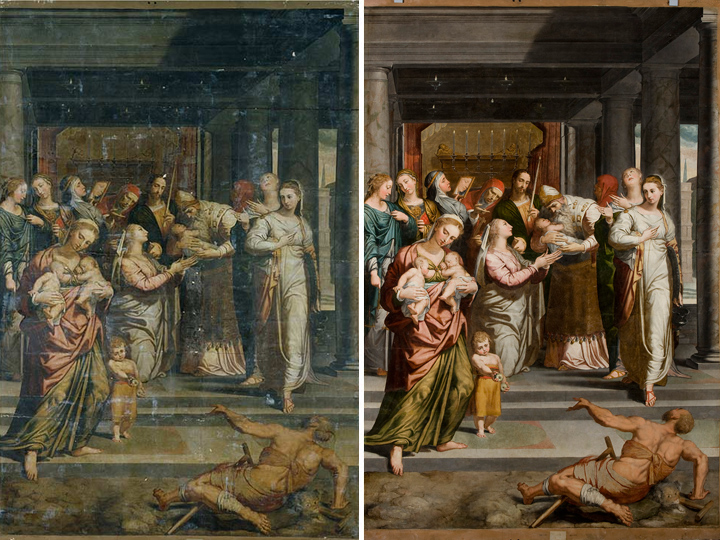
The Purification of the Virgin in the Temple, by Pedro de Campaña, before and after restoration
Introduction
Pedro de Campaña (Brussels 1503-1587) arrived in Seville in 1537, by which date he was already a fully trained master and had spent time in Italy. He remained in Seville for twenty years, undertaking major commissions, of which the one for the cathedral was among the most highly esteemed and praised.
The Purification is a complex composition that is partly based on a print by Dürer, particularly with regard to the monumental conception of the pictorial space in which the artist located an elegant, sinuous group of figures that are closely related to the work of Michelangelo and Raphael. Due to its extremely large size, the painting was executed on 14 oak panels attached together horizontally. This unusual method of construction led to continual conservation problems and made it necessary to undertake the complex process of restoration that has recently been completed by experts at the Museo del Prado.
The room in which the painting is temporarily displayed in the Museum has text panels explaining the nature of the painting and its recent restoration. In the same room visitors can also see a visual projection of the various stages of the restoration process that took place in the Museum’s conservation studios.
The painting prior to restoration
In order to appreciate the alarming state of conservation of the panel of The Purification of the Virgin in the Temple before it arrived at the Museum’s restoration studios, we need to make some reference to the panel’s earlier history and the problems that it suffered. Most importantly, the entire altarpiece of which this panel forms a part was moved and subsequently restored between 1558 and 1560, and was restored again in 1879-1880. In addition, atmospheric and other conditions and circumstances have affected its state.
Problems arising from previous restorations
The panel was broken into three parts when it was moved within the Cathedral around 1558 and was subsequently restored (1558/1560). This restoration aggravated the problems inherent to the panel and consequently affected the paint surface. Restorers at the time were not aware of modern restoration procedures and the cracks in the panel were repaired with the application of hemp and gesso, missing areas of paint were repainted, as were areas of the original paint surface, and the horizontal support beams on the back were removed and replaced with metal ones that prevented the planks from expanding and shrinking in a natural manner. The later restoration of 1879-1870 was also ill-advised. At that date the thickness of the panel was reduced to about 4cm, as it appears today, and the back sanded down, after which a structure of metal slats was attached to it that resulted in numerous and significant fractures in the wood and loss of paint.
Unfortunately, these subsequent restorations did little to solve the basic problems of the panel itself, but rather added new ones arising from the addition of later gesso layers (now extremely hard) introduced by heat and pressure (resulting in distortion), areas of re-painting using oil mixed with coloured varnishes, and very large drips or splashes of varnish or paint that have discoloured the affected area.
Problems arising from environmental conditions
In addition to the problems mentioned above, other arose from the location in which the panel was habitually located in Seville cathedral, where constant changes of temperature and humidity resulted in serious attacks of wood-eating insects, a high degree of environmental contamination (dust, spiders’ webs, candle smoke), and the presence of pigeons and in particular bats, whose excrement has had an extremely corrosive effect on the pigments.
Problems arising from the artist’s working methods
Finally, the particular technique used by Pedro de Campaña has made conservation of this work more difficult. The thick layer of preparation - binding agent (glue) and filler (gesso) was never perfectly mixed, resulting in the fact that it became less adherent over time with consequent areas that had lifted off or lost pigment. The artist’s pictorial technique, based on the application of very fine layers of paint and glazes that left the under-drawing visible, made the restoration and cleaning of this panel an extremely delicate process.
The Support
The restoration of The Purification of the Virgin, painted by Pedro de Campaña in 1556, is possibly one of the most complex projects of its kind to have been undertaken by the Museo del Prado’s restorers.
The exceptionally large size of the painting (330cm high x 240cm wide and 4cm thick) as well as its weight (almost 300 kilos), combined with the way that the panels of this vertical painting are arranged horizontally, has made it exceptionally fragile and very difficult and hazardous to move.
The cradling system was removed in order to be able to close up almost 45 metres of cracks using a system of “V”-shaped elements that have allowed for the creation of small, wedge-shaped openings following the lines of the cracks into which small pieces of wood of a corresponding shape have been fitted. These pieces of wood are of the same type and cut and are around 200 years old. In order to make this process more exact these pieces are extremely small (5 or 6 cm), thus reducing the amount of adhesive required.
A new type of supporting structure has been designed, consisting of four, mobile cross-bars. The bars have a complex system of grooves and springs inside them that have made the panel much stronger while also allowing the wood of the planks to move in all directions in response to changes in relative humidity.
The Paint Layer
In order to preserve the overall state of Campaña’s painting when it was taken out of the altarpiece in the cathedral prior to being brought to Madrid, an initial intervention was carried out by the Museum’s restorers inside the cathedral. Having reached the Museum, the panel was the first element to be restored, after which the restorers moved on to stabilising the paint layer in a gradual manner, first correcting irregularities in the gesso, then consolidating and flattening the craquelure and any colour particles that were at risk of coming loose.
Removal of old varnish and areas of re-painting
The elimination of varnish and re-painting was one of the most complex aspects of the restoration process. The paint surface was covered with various superimposed layers of oxidised varnish that were in some cases coloured with pigments, combined with dirt from the atmosphere that made it difficult to distinguish the original subtle and delicate glazes. In addition, the areas of re-painting in some cases were larger than the areas of paint loss underneath them, resulting in a delicate and laborious process to eliminate them while not removing original paint.
Re-integration of the colours
The process of re-integrating the colours has paid particular attention to the “tone” of the originals, with the aim of avoiding harsh contrasts resulting from earlier alterations, settling each space and volume in its place with the aim of recuperating the composition original perspective and spatial depth through the light and colour.
Conclusion
The principal aim of the procedure used for this restoration project was that of compensating irreversible damage and recuperating what lay beneath the various earlier restorations, while also dealing with problems resulting from the passing of time. As a result, and for the first time in more than 400 years, the Museo del Prado has the honour and satisfaction of presenting Campaña’s great work in its rooms in optimum environmental conditions and with the painting now as close as possible to its original appearance as created by the artist.



